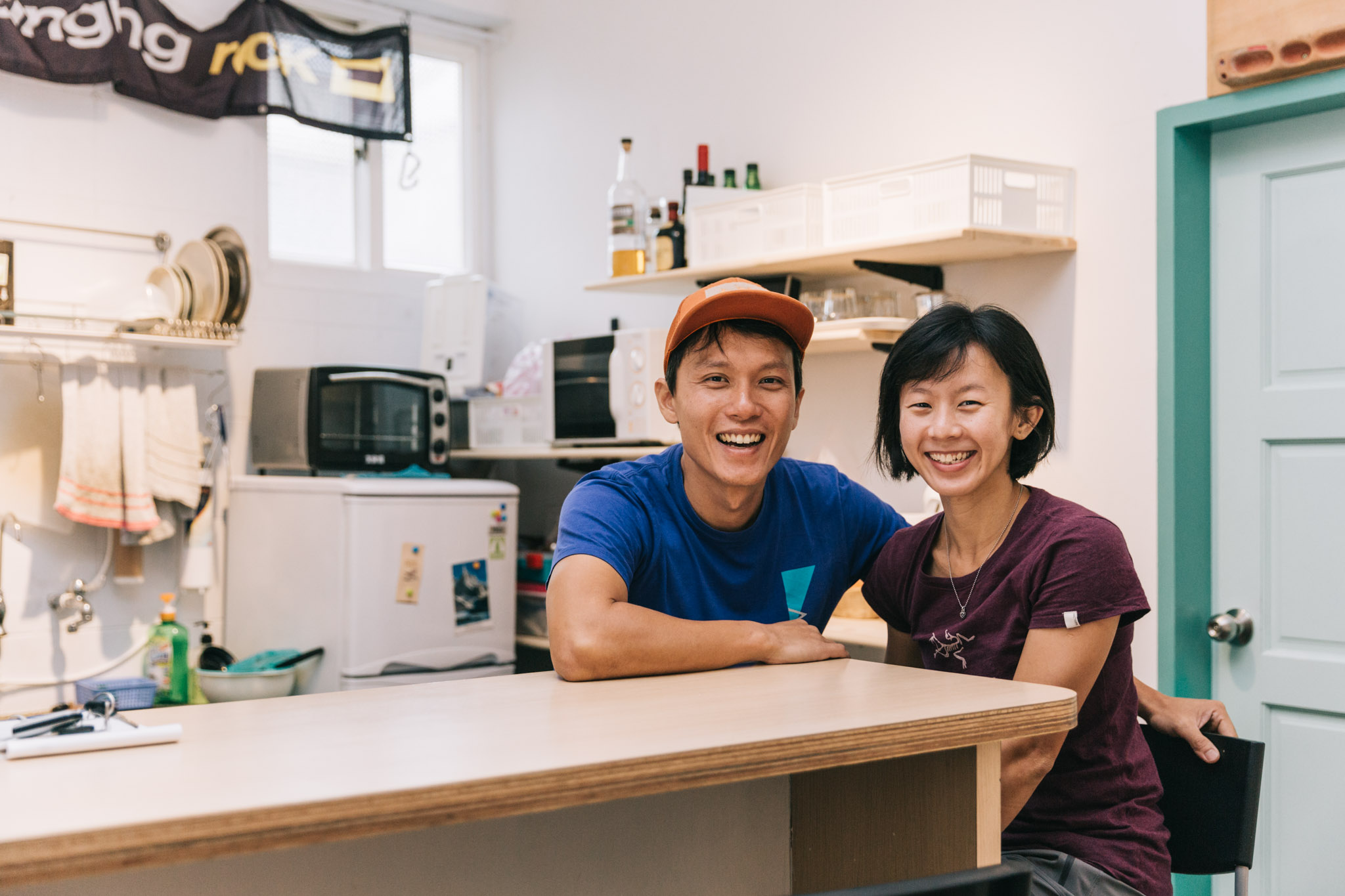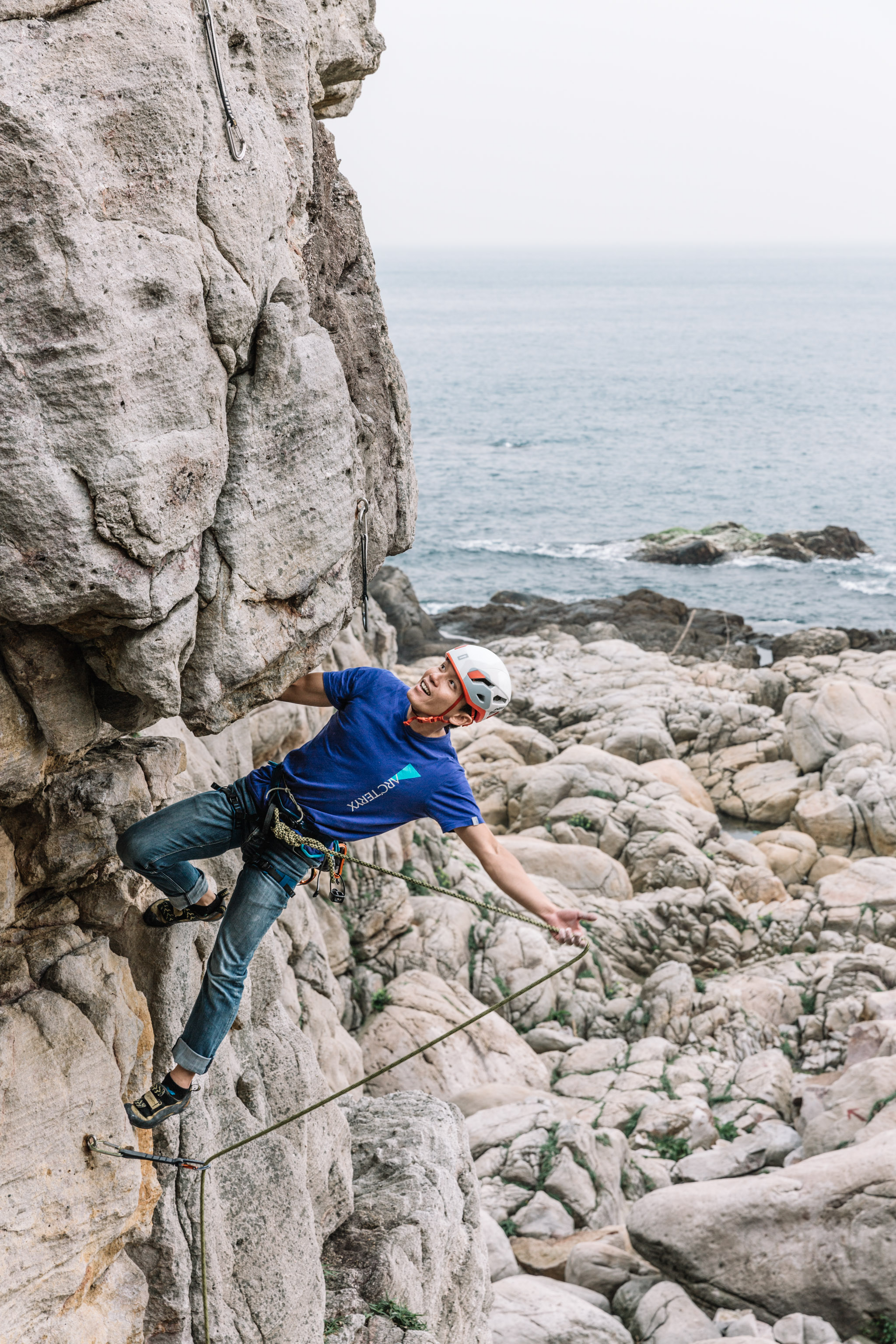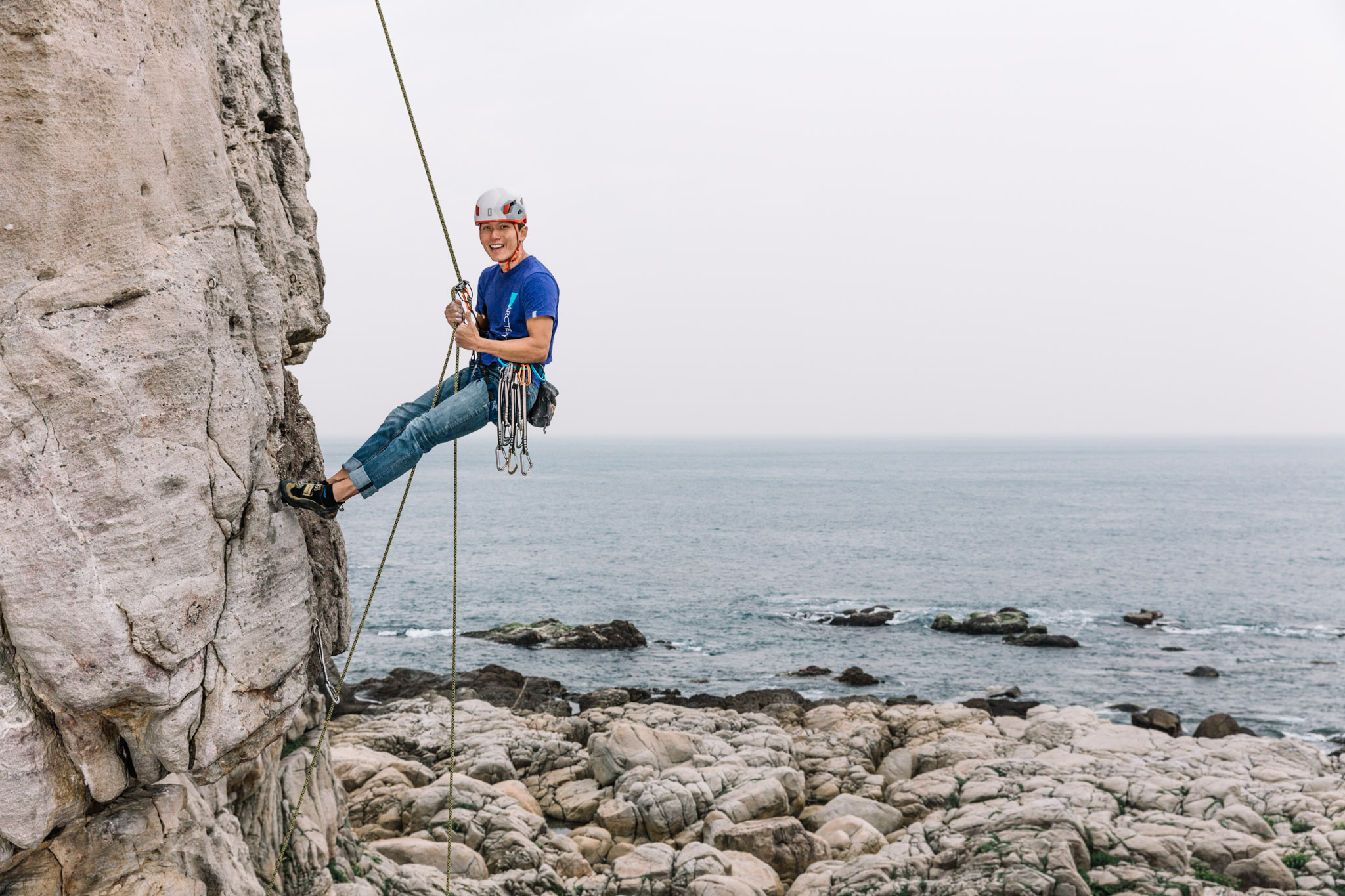Climbing for life
Cheang Qing Xin & Kelly Khiew, Singaporeans based in Taiwan
Rock climbing guides
Story by Koh Eng Beng | Photos by Charmaine Wu
Cheang Qing Xin (left) and his wife Kelly Khiew are rock climbing guides from Singapore who managed to turn their hobby into a successful business. They bring clients for climbing trips to US, Taiwan, China, Malaysia and Thailand. Home for them is the Bivy, a two-storey climbers’ hostel they own in north eastern Taiwan.
I met them at the Bivy for the interview before joining them for a mini climb at the sea cliffs nearby for a photoshoot.
Cheang was a former commando in the Singapore Armed Forces, and Khiew worked at the National Museum of Singapore. They could have made a comfortable living from their stable and well-paying jobs, but they left in 2013, just six months after they got married and bought a house. Crazy? Maybe, but deep in their heart, they wanted something more.
“Out of 365 days a year, we only had 21 days of annual leave to go where we want to be for rock climbing. That’s totally not cool,” said Cheang.
They dreaded climbing the artificial walls in the gym, but there were no mountains or cliffs to climb in Singapore. It got so bad that Khiew almost gave up the sport because she was “not having fun anymore”. Today, she can climb as and when she likes since her home is near the Long Dong sea cliffs, a popular climbing spot in Taiwan.
The couple holds the distinction of being the first Singaporean couple to reach the summit of El Capitan, in 2011. As climbing guides, they lead climbing hikes and conduct classes for beginners as well as professionals. Sixty percent of their clients are Singaporeans, the rest are foreigners mostly from US and Europe.
Here’s a low down on what they did to turn their hobby into a full-time career.
How did you guys get started?
Cheang (C): We moonlighted at the start! We brought clients for two to three trips to Taiwan. It’s like a preview. Because we weren’t sure whether we would like it. Climbing is one thing, but taking people out to climb is another. It is actually more than just climbing. We have to hold their hands when we walk into the trail, patch them up if they get a cut. We also have to tailor our teaching to climbers of different abilities.
Khiew (K): We were taking weekend offs and leaves to bring people out for climbs. That’s what we were doing until a point that we couldn’t balance the work with our day job.
C: We didn’t exactly have a clear idea of how everything would turn out. (But) I thought this might work so I put up a timeline and a plan. If we want to do it, we better go all out. We cannot be half-hearted, and still hold on to a job.
Everyone has dreams, but to turn your hobby into a business is scary. I’m sure you guys had fear about not having enough money, right? How did you guys overcome the fear?
K: For me I didn’t really know what I was in for. I didn’t really quit my job, I had a one year no-pay leave in 2013, and then I extended my no-pay leave. I didn’t quit the museum because I didn’t like my job. I really liked my job. I was doing group visits and guided tours. I learnt a lot from my colleagues because they were really passionate about what they do. I like it there because aside from doing the job, you are learning from the exhibitions and the people you talk to.
C: It started from deciding to quit my job. I started to draw plans — 5-year plan, 10-year plan. I told myself if I leave my job, I can control my future. Even if I make less money, it’s fine because I’ve achieved a certain amount of financial freedom. I started investing when I was very young. I bought my first property, a condominium, when I was 22. Back then, it was very cheap. But I didn’t make much from my first property because I sold it just two to three years later.
When I made my plan to leave my job, I sold my (second) property. I knew I had to dispose my property, and save enough money. I had a (target) sum in my mind. I reduced my debts to the point that when I left my job, I only had one bill to pay – handphone bill.
“You have to stress test your lifestyle so that you’ll know if you can survive with $1000 or $800 a month, or whatever the amount. Then I asked myself if I can earn that amount of money when I’m out of job. ”
During my exit interview, the interviewer asked me, “You just bought your house and got married, how are you going to survive?” I told him that if I work in Starbucks I can survive. I had already stress tested my lifestyle so I knew it’s going to work.
K: But it’s not the same for everybody. Not everybody can get out of their comfort zone. In Singapore, it’s very comfortable. If you’re not picky, you will be able to survive.
C: But people don’t want to take those jobs because they are worried about what their relatives would think if they see them working in Gong Cha (now defunct bubble tea retail chain in Singapore). But if you need the money, you will do whatever it takes. In my life, I did many jobs before. When I was studying in polytechnic, I worked as a security guard and dishwasher. I know I can survive, it’s not so bad. I set aside about 4 to 5 years worth of savings. I gave myself 3 years to see whether the business will work. It will get better if we work hard. So we just keep getting better, work hard, and never say no. We just try our best. It’s about making it work, not only for yourself, but for the clients who come to you.
What advice would you give to young people who want to pursue their passion?
K: They have to be prepared to work really hard. For young people these days, many things are given to them. A lot of things are given to me out of my parents’ expense. One thing that we take for granted is the ability to choose your path.
For my parents, they didn’t have the opportunity to choose a destination for themselves. They were not highly educated. They ended up doing something they didn’t have passion for, just to earn the cash to feed the family. My dad used to be a sailor and he really liked it, but because of family obligations, he had to take over my grandfather’s provision shop. If he had a chance, he would be pursuing something very different from what he is doing now. This is why he gave us the option to choose what we want.
When we embarked on this journey, they felt that climbing was dangerous and questioned how long we could do this, but they didn’t stop us from doing it, they just quietly supported us and that’s something that I really appreciate.
How do you differentiate yourself from the competitors?
K: What we are doing is something very different. It’s private guiding, and it depends on the experience of the people.
C: We look at each person’s requirements. Sometimes we go to his or her Facebook to get a rough idea whether this person is a complete beginner or a seasoned climber. You cannot use a beginner’s programme for someone who has already climbed for ten years.
It’s also more fun for us because we are constantly changing our routine. If you climb the same route for 20,000 times, you’re gonna get super bored. You’re gonna close your eye and ‘dance’ up the mountain.
But that’s what a lot of people are doing. They are just in their comfort zones. For instance, if a route is occupied by someone else, they will just hang around and wait. They haven’t been to other routes so they don’t want to take the risk, or take the time or effort to bring people somewhere else.
The thing is, it has got to be fun. If I don’t enjoy the climbing there, even if it’s really good for business, I don’t want to be there. A friend of mine told me, “If you’re not happy, your client can feel it because you’re so close to the client whom you’ve been climbing with for the past hours.”
I find it to be true. When I go back to Singapore and meet service staff, it’s very obvious that they don’t want to be working there. They don’t tell you they don’t like their job, but just talking to them, you’ll know this guy doesn’t want to be there. What does this mean for a service business? Anybody can buy ropes and climbing equipment and be a guide. So the difference is the service that you provide.
C: Our trips are very simple, we just require clients to buy an air ticket to the country, and we take care of all other things. We pick them up from the airport, they stay at The Bivy, we take them out for dinner, and the next day we go climbing. At the end of the trip, I take them back to the airport if they are going home. Otherwise, I bring them to Taipei where they go for their own tour.
In US, we often go to the Yosemite National Park. A lot of youngsters like to climb with us, and experience sleeping on the walls overnight. We pick them from the airport, bring them to the campsite, pitch a tent, or rent a cabin (for people who want more comfort). We take them for a climb and come back. When we are done for the day, we bring them back to San Francisco.
K: That’s what people like about us. They don’t have to plan their trip, and think about the logistics. In other countries, guiding is just guiding. You have to make your way to the meeting point, and the guides just bring you up to climb and bring you back to where you started (either at the wall, or at their office which is around the area). They don’t care about what you eat.
C: In US, we prepare food because you can’t eat pizza and burger everyday. That’s why we have our chef Kelly! Even when we are very tired, we make curry chicken with rice. It feels different, you will feel like it’s a home away from home.
Climbing is physically demanding. Have you ever thought about what to do when you grow old?
C: The older guides I’ve met made me feel that you could keep working no matter how old you are. I know this guy who is in his 50s and still taking people out for climbs. But when you’re in your 50s, you have a different client base. They are people in their 40s and 50s. Could you imagine a 50-year-old guy climbing with a 25-year-old guy? This dude is like his son. He is not going to be able to keep up, and the younger guy will become impatient.
K: It helps a lot that we are starting at our age. We meet people who grow old with us. Of course you have to adjust according to time. When you’re old, you cannot be working 25 or 30 days a month.
C: A lot of people treat their customers as a liability. But they don’t understand that without your customers, you will not be able to do what you’re doing. They provide the service just because they are getting paid. When you meet these people, it makes you feel bad that the industry has stoop to this level. The industry doesn’t “retain” people who truly enjoy climbing, who truly enjoy showing people the way of the sport. It’s just filled with people who want to make money the quick way.
K: There are also people who will change along the way. I can understand how people get tired while doing it and slowly they feel that “I don’t have to do this personally anymore. I can get people to do it for me, and I just have to manage. Micromanage.”
C: That’s the most common question I get from Singaporeans. “How long do you think you’ll do this? You will grow old and you will not be able to do this anymore. Why don’t you just build a team who can guide for you?”
Maybe eventually I will get one or 2 guides to work for me, but that’s not the whole idea. The whole idea of doing this is because you want to do it, not because you are trying to make a living. You are doing it because you enjoy being out here.
K: I don’t want to end up being the person in the office, punching keyboards. I want to be out there.
C: Yes, then I will be replying emails all day. That defeats the purpose. That will be like running a business. I don’t tell people I’m running a business per se, I tell them that I’m a climbing guide who takes people out to climb.
K: He’s still replying emails, but he’s doing it out there on his phone!
C: Yes, in the mountain valley where I get very poor reception. When you get out, your emails start to flood in. Sometimes when I’m on the ledge on the way to the summit, people are taking photos and selfies, I will quickly reply one or two emails!
Does working together with your spouse help?
C: It’s not just about climbing, it’s more about sharing the same ideas and we understand what each other is trying to do; our goals are quite common, like the lifestyle we want. Whatever we do, we don’t want to go back to the Singapore city life or corporate life.
K: Also, because in Singapore, we don’t have a place for outdoor climbing. If I were to stay in another place, I could still go climbing as and when I want to, even over the weekend, I would still be happy. But at that point of time, I felt that most of my time, my life, was trapped in a place that I don’t want to be. And that’s because in Singapore you can’t go climbing.
What’s your greatest takeaway from turning your climbing hobby into a career?
K: I feel more alive because I am doing it for myself. I feel that I have more time and that’s very important to me. I don’t have the obligation to be in an office, or work 8 hours a day. I have more flexibility to plan my time.
Other than the work itself and being able to climb more, I get to spend a lot of quality time with my friends and family. Although we are physically apart now, I feel closer to them emotionally whenever we come back.
C: For me, it’s responsibility. In the past, someone else would hold you responsible. Now I find myself responsible for my work so I cannot accept low standards. I cannot accept seeing someone doing something that is not right. If it’s not safe, it’s not safe. A lot of people will brush it aside and say “it will not happen” (referring to accident). But I will tell my client to give me a minute, I will climb somewhere to cut some old ropes out.
Finally, what are your future plans for your business?
K: We thought about having a Bivy hostel in Yosemite as well. It’s a wild idea but it’s possible!
C: When we retire, we will just go from country to country to look after the hostel chain, haha. No lah, hosteling will not be our main business. But we will still do it because it’s useful for taking people out to climb and showing them the life of a climber.



















